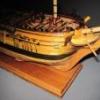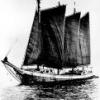-
Posts
439 -
Joined
-
Last visited
Reputation Activity
-
 Mike 41 got a reaction from Saburo in Washington 1776 by Mike 41 - FINISHED - 1:48 - row galley
Mike 41 got a reaction from Saburo in Washington 1776 by Mike 41 - FINISHED - 1:48 - row galley
The following set of photos show how I made the hawse pieces. I glued the hawse pieces into two blocks and roughed them out on the bandsaw and finished shaping them with a small drum sander.
-
 Mike 41 got a reaction from Saburo in Washington 1776 by Mike 41 - FINISHED - 1:48 - row galley
Mike 41 got a reaction from Saburo in Washington 1776 by Mike 41 - FINISHED - 1:48 - row galley
Hi Daniel,
Thanks, I like to use ribbands on the amidships section and small jigs at the bow and stern. I won’t be filling the space between the frames on this ship but I will on my next build.
I made a small saw tooth jig to hold the bow cant frames in place while the glue dried. These photos show how I used it.
-
 Mike 41 got a reaction from Saburo in Washington 1776 by Mike 41 - FINISHED - 1:48 - row galley
Mike 41 got a reaction from Saburo in Washington 1776 by Mike 41 - FINISHED - 1:48 - row galley
Hi Daniel,
The US galleys were mostly designed to operate in coastal waters and rivers and had broad beams (a lot like my wife) LOL. I am using 20 gauge brass wire to bolt the frames together it does a nice job.
These photos show the framing plan and the frames being dry fitted in the keel.
-
 Mike 41 got a reaction from Saburo in Washington 1776 by Mike 41 - FINISHED - 1:48 - row galley
Mike 41 got a reaction from Saburo in Washington 1776 by Mike 41 - FINISHED - 1:48 - row galley
Thanks Patrick, I will be posting a lot more pictures.
Hi Daniel,
Thanks she will make a nice looking model. I bought the level at Lowes and it is available thru the Inet.
The frames are all double frames made from European Beachwood. This set of photos shows the frames being assembled.
-
 Mike 41 got a reaction from Saburo in Washington 1776 by Mike 41 - FINISHED - 1:48 - row galley
Mike 41 got a reaction from Saburo in Washington 1776 by Mike 41 - FINISHED - 1:48 - row galley
This is a few photos of the keel assembly. The keel is made from European Beachwood and the false keel is rosewood.
-
 Mike 41 got a reaction from Saburo in Washington 1776 by Mike 41 - FINISHED - 1:48 - row galley
Mike 41 got a reaction from Saburo in Washington 1776 by Mike 41 - FINISHED - 1:48 - row galley
History:
Source DICTIONARY OF American Naval Fighting ships
There had been eight different ships named USS Washington.The third Washington—a lateen-rigged, two-masted galley—was built on Lake Champlain at Skenesboro N.Y., in the autumn of 1776. On 6 October 1776, the galley joined the small fleet established and commanded by Brigadier General Benedict Arnold.
Washington—commanded by Brigadier General David Waterbury, Arnold's second in command—was among Arnold's ships that anchored in the lee of Valcour Island to await the expected English move. When that lakeward push began, Capt. Thomas Pringle, RN, led a 25-ship fleet past Valcour Island on 11 October. Pringle sighted the American fleet after he had passed it and attacked from leeward. In the ensuing action, Washington suffered the heaviest damage of any ship in Arnold's fleet; Waterbury, her commander, subsequently reported that she was ". . . so torn to pieces that it was almost impossible to keep her above water."
Arnold regrouped his shattered fleet and slipped past the British on 12 October with muffled oars, the Americans slipping noiselessly past Pringle's fleet in a desperate attempt at escape. However, after a long chase, the British caught the retreating Continental force the following day, on 13 October, at Split Rock near Crown Point.
Arnold managed to beach and destroy four of the galleys and his own flagship, Congress, while most of the remaining ships escaped upriver. Only Washington —at the rear of the van—was captured by the enemy; she struck her colors, as Arnold reported later, "... after receiving a few broadsides."
Washington was eventually taken into British service, apparently retaining her name, and was re-rigged as a brig. Her subsequent fate, however, is unrecorded.
The Model:
The model was designed by Jeff Staudt and is one of several he designed in a series of models of ships used during the war of 1812.
The building board I use is a gantry type and I thought I would include a couple pictures of it with the framing plan in place.
-
 Mike 41 got a reaction from mcpwilk in HMS Beagle 1820 by Mike 41 - 1:48 scale - Cherokee-class brig-sloop
Mike 41 got a reaction from mcpwilk in HMS Beagle 1820 by Mike 41 - 1:48 scale - Cherokee-class brig-sloop
The lower deck planking and interior lining is in place. The stove will be built and installed next.
-
 Mike 41 got a reaction from mcpwilk in HMS Beagle 1820 by Mike 41 - 1:48 scale - Cherokee-class brig-sloop
Mike 41 got a reaction from mcpwilk in HMS Beagle 1820 by Mike 41 - 1:48 scale - Cherokee-class brig-sloop
The mast steps, limber strakes and limber boards are shown in this set of photos.
-
 Mike 41 got a reaction from bdgiantman2 in Washington 1776 by Mike 41 - FINISHED - 1:48 - row galley
Mike 41 got a reaction from bdgiantman2 in Washington 1776 by Mike 41 - FINISHED - 1:48 - row galley
Hi Chuck,
The captain like fresh donuts with his tea for brunch on the Washington. You need to get a better cook on the Philadelphia.
Mike
-
 Mike 41 got a reaction from Deperdussin1910 in HMS Beagle 1820 by Mike 41 - 1:48 scale - Cherokee-class brig-sloop
Mike 41 got a reaction from Deperdussin1910 in HMS Beagle 1820 by Mike 41 - 1:48 scale - Cherokee-class brig-sloop
The mast steps, limber strakes and limber boards are shown in this set of photos.
-
 Mike 41 reacted to DocBlake in Chapman Water Hoy 1768 by DocBlake - 1:48 scale
Mike 41 reacted to DocBlake in Chapman Water Hoy 1768 by DocBlake - 1:48 scale
I happened to have a copy of the March, 1993 issue of Model Boats magazine which had an article by Peter Danks about building this small coasting vessel. It included a full set of plans, which I had digitized so I could copy selected parts of the plans as needed. The model is about 13” long without the sprit, so enlarging the plans to 1:32 results in a model that is still reasonable for the average house! I abandoned my usual preference for larger scales and decided to build at 1:48 for a change of pace!
The construction technique in the original plans was weird. It employed a strange jig that was INSIDE the model, and the model was built upside down, with extensions glued to the jig like a Hahn style POF. The model was then cut from the jig after planking the exterior. I decided to go a different way. I converted the skeleton to a typical POB model, with a central false keel and bulkheads. This was challenging because the plans don’t include a water line or bearding line and the station lines, which form the basis of the bulkhead, are poorly drawn.
I made up foam board mockups of the bulkheads and false keel before I made the final versions in basswood. The first photo (on page 2 of Danks’ article) shows the odd construction plans and the weird up-side-down inside out jig. There is even (un-necessary) deadwood! The second photo shows the profile and the station lines which I used to draw the false keel and plan the bulkhead locations. The third photo shows the sheer line of the deck drawn in, which defines the top of the false keel as well as the slots for locating the bulkheads.
-
 Mike 41 reacted to DocBlake in Chapman Water Hoy 1768 by DocBlake - 1:48 scale
Mike 41 reacted to DocBlake in Chapman Water Hoy 1768 by DocBlake - 1:48 scale
Thanks for your interest, guys!
There are a lot of real challenges involved in building this little ship…not the least of which is the extended hatch to the cargo hold. The framing for than long hatch curves across the beam to match the deck camber, but also fore and aft to match the deck sheer. I plan to also change the wooden slats which cover the hatch opening from flat to curved. Lots of solid geometry to contend with. I suspect that part of the build may take a month to complete, with multiple trial and error attempts. Challenging and fun!
-
 Mike 41 reacted to DocBlake in Chapman Water Hoy 1768 by DocBlake - 1:48 scale
Mike 41 reacted to DocBlake in Chapman Water Hoy 1768 by DocBlake - 1:48 scale
Chapman Hoy Scratch Build 1:48 scale
This will be my log for a 1:48 scale (actually 1:50 scale as all the plans are metric) scratch build of a Chapman Water Hoy. A hoy is a small vessel, designed to move cargo and supplies to and from ships and the shore. These included provisions, munitions, fresh water etc. Hoys were sloop-rigged, with a mainsail on a gaff, but loose-footed (no boom). Fifty tons burthen was typical for size. This hoy had a large beam and draft for her length to maximize carrying capacity. The Chapman Water Hoy was designed by Fredrik Henrik af Chapman, a Swedish ship designer in 1768. This is an odd little ship but very interesting and with a simple rig. She was built for a life of hard work. The photos show three drawings of the vessel and a model photo i found on the internet.
Another reason I chose her to build is to spare the world another "Victory" or "Syren" build log! LOL!!
-
 Mike 41 got a reaction from CiscoH in HMS Beagle 1820 by Mike 41 - 1:48 scale - Cherokee-class brig-sloop
Mike 41 got a reaction from CiscoH in HMS Beagle 1820 by Mike 41 - 1:48 scale - Cherokee-class brig-sloop
This is a few photos of the hammocks as installed on the model.
-
 Mike 41 got a reaction from Saburo in Washington 1776 by niwotwill - scale 1:48 - Row Galley - NRG plans #121
Mike 41 got a reaction from Saburo in Washington 1776 by niwotwill - scale 1:48 - Row Galley - NRG plans #121
Hi Will, your frames are looking particularly good. Using the bolt holes to align the frames works well. The frames seem to go a little faster when you see the hull taking shape.
Mike
-
 Mike 41 got a reaction from Saburo in Washington 1776 by niwotwill - scale 1:48 - Row Galley - NRG plans #121
Mike 41 got a reaction from Saburo in Washington 1776 by niwotwill - scale 1:48 - Row Galley - NRG plans #121
-
 Mike 41 got a reaction from Archi in HMY Fubbs 1724 by Mike 41 - Scale 1:48 - second rebuild
Mike 41 got a reaction from Archi in HMY Fubbs 1724 by Mike 41 - Scale 1:48 - second rebuild
The forward stays as installed.
-
 Mike 41 got a reaction from Archi in HMY Fubbs 1724 by Mike 41 - Scale 1:48 - second rebuild
Mike 41 got a reaction from Archi in HMY Fubbs 1724 by Mike 41 - Scale 1:48 - second rebuild
This is some progress photos of the lower shrouds.
-
 Mike 41 got a reaction from Archi in HMY Fubbs 1724 by Mike 41 - Scale 1:48 - second rebuild
Mike 41 got a reaction from Archi in HMY Fubbs 1724 by Mike 41 - Scale 1:48 - second rebuild
This is a few photos of the anchor, pump and ship bell.
-
 Mike 41 got a reaction from Archi in HMY Fubbs 1724 by Mike 41 - Scale 1:48 - second rebuild
Mike 41 got a reaction from Archi in HMY Fubbs 1724 by Mike 41 - Scale 1:48 - second rebuild
The drawings have good details for the masts and tops. I started with the tops then built the masts. The masts are built but I am going to add the guns and other deck items before stepping them.
-
 Mike 41 got a reaction from mcpwilk in HMS Beagle 1820 by Mike 41 - 1:48 scale - Cherokee-class brig-sloop
Mike 41 got a reaction from mcpwilk in HMS Beagle 1820 by Mike 41 - 1:48 scale - Cherokee-class brig-sloop
The bow was looking awful plain so I added the bowsprit and gammoning, false rail, naval hood, wash cant, lower and main rails, and bumpkins. This is a few photos of the installation.
-
 Mike 41 got a reaction from AJohnson in HMS Beagle 1820 by Mike 41 - 1:48 scale - Cherokee-class brig-sloop
Mike 41 got a reaction from AJohnson in HMS Beagle 1820 by Mike 41 - 1:48 scale - Cherokee-class brig-sloop
This is a few photos of the hammocks as installed on the model.
-
 Mike 41 got a reaction from uncarina in HMS Beagle 1820 by Mike 41 - 1:48 scale - Cherokee-class brig-sloop
Mike 41 got a reaction from uncarina in HMS Beagle 1820 by Mike 41 - 1:48 scale - Cherokee-class brig-sloop
Hi Pat,
Thanks, the ATOS books are a great resource but not perfect use with caution.
As I understand storing the hammocks in the crane racks afforded the gunners protection against small arms fire. The hammock would stop musket balls during battles. I would think the crew would sleep on the upper deck during good weather, I know I would.
Scratch building a pof ship model gives you a better understanding of the components of the actual ship. I would suggest a cross section for your first scratch build, they give you an idea of the time an effort it takes to make all your own pieces.
Good luck with the HMS Endeavour.
Mike
-
 Mike 41 got a reaction from AJohnson in HMS Beagle 1820 by Mike 41 - 1:48 scale - Cherokee-class brig-sloop
Mike 41 got a reaction from AJohnson in HMS Beagle 1820 by Mike 41 - 1:48 scale - Cherokee-class brig-sloop
The bow was looking awful plain so I added the bowsprit and gammoning, false rail, naval hood, wash cant, lower and main rails, and bumpkins. This is a few photos of the installation.
-
 Mike 41 got a reaction from uncarina in HMS Beagle 1820 by Mike 41 - 1:48 scale - Cherokee-class brig-sloop
Mike 41 got a reaction from uncarina in HMS Beagle 1820 by Mike 41 - 1:48 scale - Cherokee-class brig-sloop
This is a few photos of the hammocks as installed on the model.






